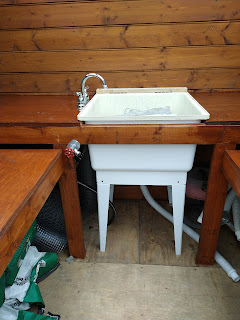I am from the ones who think that what we are now or at a given time is the sum of our past experiences, choices we made and people we met. The reason why I like woodworking is maybe the result of people I had the chance to meet before, who influenced my life, like my great grandfather who was a sawyer and carpenter.
Some 25 years ago, while doing some volunteering in a museum in France, I met a wood carver who was invited to that museum for a cultural exhibition. The name of that person was Norbu-la and he was coming from a Tibetan refugee village in Dharamsala in north India. The goal of that exhibition was to showcase art of wood carving in Tibetan culture by carving a Tibetan altar made of teak.
 |
| Norbu-la, Tibetan carver in front of his teak altar |
During his stay I had the opportunity to spend quite some time with him and to learn about how he was working and to give it a try.
 |
| Example of the carver skills... |
 |
| ...and of mine! |
This was also an opportunity to look at the tools he was using, especially that these were mostly homemade.
 |
| The carver tools, squares, saw, chisels, marking gauge. |
Among these tools some are particular to notice.
First of all, the coping saw. That saw was made with a piece of bamboo, shaped into a U form. Bamboo being very flexible it was keeping the tension on the blade like a spring, very clever.
The saw blade itself was very particular. It was made using a steel wire reclaimed from old tires inner reinforcement wires. The steel was quite mild but still very resistant. The wire was rolled on one side of the bamboo frame, serving as a reserve, and attached at the other end. Before being usable, the carver was cutting very small teeth in the wire using chisel and mallet. When the blade was broking, he would just unroll a new piece, cut the teeth and back to work.
Surprisingly that saw was cutting very well even in hard wood and was very nice and easy to use. The bamboo frame being very well balanced and the saw was easy to handle.
Other tools to notice were the carving chisels. A lot of them, the smallest ones, were made from motorbike wheel spokes. From what he told me the steel used for spokes is a very good quality steel that can handle a heavy tension. They used the spokes as the raw material that was forged into the final chisel. I can assure that these chisels were razor-sharp, my finger will never forget how easily it was to deep cut it.
To sharpen these chisels, the carver was using a black stone, that he carefully selected in the bed of a river and broke in two pieces to have a flat face. I do not know what kind of stone it was but it was very soft to touch and had a fine abrasive grain. He poured water on the stone and honed a chisel for a minute and he was done.
So looking at the quality of his work, and the simple tools he was using, one question comes to my mind:
Are the tools making the man, or the man who makes the tools?


























































